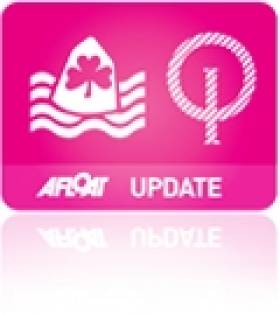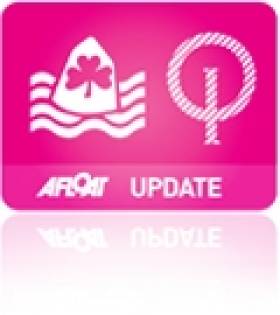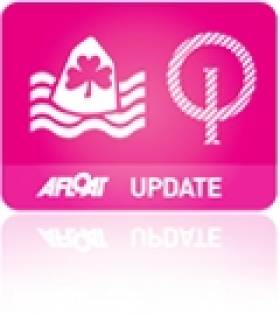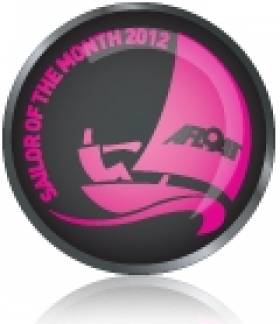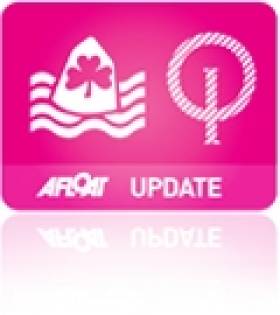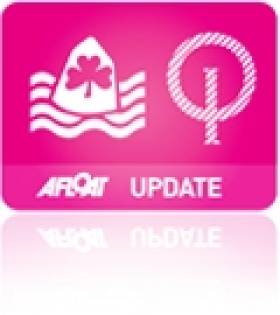Displaying items by tag: Optimist
Royal Cork Optimists Head for Waterford in Strong Position
#OPTIMIST – Royal Cork Yacht Club Optimist sailors go into the second leg of the 2012 trials in Dunmore East in County Waterford in a very strong position next weekend. Four of the top five sailors are Royal Cork sailors after the first leg thus putting the Munster helms in a strong position to represent Ireland at the Optimist Worlds in the Dominican Republic in July.
Coaches George Kingston and Katie Tingle report that alll 19 sailors performed exceptionally well under very difficult and tricky conditions in Dun Laoghaire at the recent Mistubishi Youth Nationals.
Irish Dinghy Sailor Wins Optimist Consul Cup
Racing for a huge trophy sponsored by the Estonian Consulate in Denmark Ireland's Sophie Browne has won the Consul cup after an intense period of practice at an international Sailfast training clinic.
The 2012 Consul Cup was dominated by girls occupying the first seven places overall. Tralee Sailing Club's Browne seemed to have an extra gear throughout the three days of racing, scoring a total of 10 points out of six races before she could lift the massive trophy. The trophy was presented by the Estonian Consul of Denmark, Mr. Thomas Graversen.
Runner up was Lærke Graversen who won a tie with Cille Smedegaard who ended up third.
Browne of both Tralee Bay and Royal Cork became the Afloat.ie/Irish Independent "Sailor of the Month" for January after taking the Silver Medal in the Girls Division in the Optimist Worlds in New Zealand. She added it to the Gold in the Girls, and fourth overall, which she won from an enormous fleet in the last major European regatta of 2011, at Palma, Mallorca in December.
Optimistic sailors for the future
On a beautiful unrivalled sunny Sunday, Monkstown Bay Sailing Club, Cork, held its first Open Day of the season for aspiring Oppie Sailors. The Village could have been St. Tropez, full of colour, with people everywhere and conditions on the water summerlike and ideal for the purpose of the youngsters getting a taste of sailing. Their enthusiasm and the happy sounds resounding across the water gave an indication of their enthusiasm.
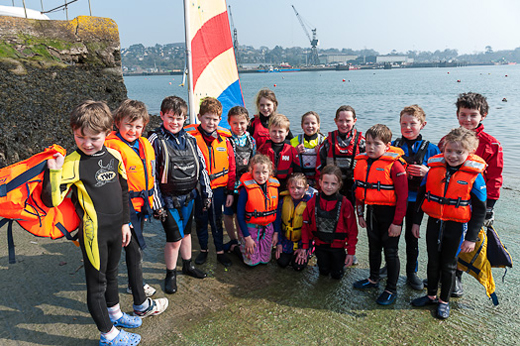
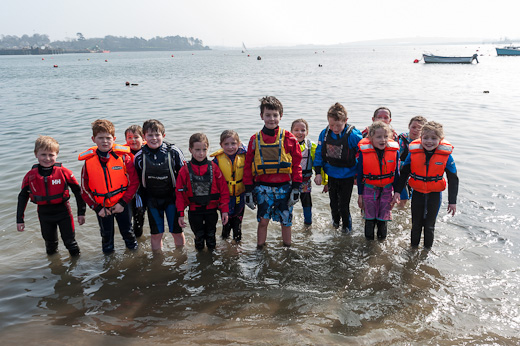
How to Start Your Child Sailing – An Introduction to the World of the Optimist Dinghy
#OPTIMIST – What is an Optimist dinghy?
The Optimist is, quite simply, the dinghy in which the young people of the world learn to sail writes Joan O'Sullivan of the Irish Optimist class
Specifications - 2.31m (7'6.1/2") long, 1.13m (3'8") wide. Weight 35kg (77lbs).
Easily transported on top of any car, safe and simple enough for an 8-year old, exciting and technical enough for a 15-year old.
Sailed in over 110 countries by over 150,000 young people, it is the only dinghy approved by the International Sailing Federation exclusively for sailors under 16 years of age.
Over half of the dinghy skippers at the last Olympic Games were former Optimist sailors.
The boat was designed by Clarke Mills in Florida in 1947; they first came to Europe in 1954 when a fleet started in Denmark.
Most parents find that sailing gives young people a great sense of personal achievement. In addition the skills required to improve sailing performance both on and off the water; it helps young people develop a more organised approach to other non-sailing related activities.
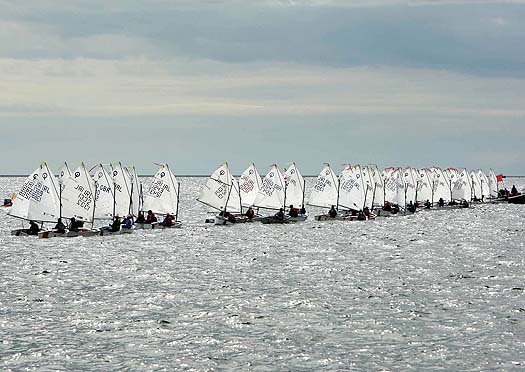
A busy Optimist start line at Dunmore East. Photo: Noel Browne
How many Optimists are there in Ireland?
More than 1,450 Optimists have been registered in Ireland to date.
At Optimist events in Ireland this year the fleet size varied between 120 at Regional events and 200 at our National Championships. International events can be much larger and at an Easter Regatta on Lake Garda in 2011 there was just short of 1000 boats.
How can I join a sailing club that sails Optimists?
There is a network of over 70 sailing clubs in Ireland and a network of commercial sailing schools too. The junior or dinghy sailing coordinator in each club should be able to tell you if they have an active Optimist class in that club. Your interest could be the spark that ignites an Optimist interest there and IODAI will endeavour to support clubs who wish to start an Optimist fleet.
Alternatively, contact the International Optimist Dinghy Association in Ireland(IODAI). This is a voluntary association, primarily comprised of parents of Optimist sailors, who organise events for the Optimist class. Iodai have a very informative, active website at www.iodai.com. If you contact the IODAI secretary directly, [email protected] you will be put in touch with an IODAI regional representative who will guide you towards a suitably active Optimist club.
What age should a child start sailing Optimists?
Some clubs do not provide beginner training under 9 or 10 years of age. However this is changing and you should check with your local club. See if any other experienced parent can suggest how a younger sailor might start.
There are plenty who start earlier and eleven or twelve is not too late - even to get to the top in the fleet.
Some considerations before beginning:
· Is your child a competent swimmer? (Competent means comfortable in the water when out of depth and capable of swimming say 25 meters in the sea water while dressed in normal clothing).
· Comfortable about the prospect of trying sailing? (The prospect of being alone in charge of a boat is often daunting to a young child and this introduction to the water is the most important step).
· Are there any older brothers, sisters or friends involved in sailing? This is often a great help.
· Is the child and are the parents prepared to make the commitment? There is a lot of time involved in junior sailing. Parents, remember, they can't drive themselves to training or events and they need lots of help ashore especially in the early days.
IODAI contact every sailing club from time to time to determine their level of interest in the Optimist class and to maintain an open invitation for any sailing club to seek assistance in the forming of an Optimist class at that club.
My child has done some sailing courses at our local club, what next?
There is a vibrant racing circuit in Ireland for the Optimist class.
Most clubs have a racing season which runs from late spring until the end of the summer, and they also hold their own annual dinghy regattas which normally include Optimist racing and are an excellent way to begin racing.
Once a child has done a little racing, they can look outside their own club. IODAI hold a full series of events specifically for Optimists; 4 regional 2-day events, the Optimist Nationals in August, Spring training week in Baltimore, and an Autumn training week. These events are open to children at all levels.
The Spring training week (13-17 February 2012) - 5 days training with a variety of coaches, national and international, and a mixed ability group of 150 sailors - is an ideal way to begin sailing outside the sailor's own club and for a child to meet other sailors of their own level.
Local club Junior Co-ordinators will have information about all Optimist events. The IODAI website is also a wealth of information for those starting out.
The Optimist dinghy is a simple and safe; designed specifically for young sailors. So, no matter what other boat a child has used on their courses, they should be able to handle an Optimist.
Are Optimists suitable for girls?
The Optimist provides superb one design racing where boys and girls can compete on equal terms. Yearly rankings often produce a 50:50 split between boys and girls. In 2005, 2006 and 2007 the Irish National Championship was won by Diana Kissane, from Howth Yacht Club who set a record by winning the title in three successive years.
In 2011, the Trials series (selection process for the year's international teams) was won by Sophie Browne from Tralee; the National Championships 2011 were won by Sean Donnelly from Dun Laoghaire, so boys and girls continue to compete equally.
How do they start racing?
As a Junior Class we have knowledge of helping sailors make the transition from "messing about in boats" to actual racing. This is where our innovative Regatta Fleet comes in.
Regatta Fleet Racing is for beginners and unranked sailors - usually from age 8 upwards. The focus of the Regatta Fleet is on having fun. There is a Regatta Fleet element at most major Optimist events except the Trials series.
The Regatta Fleet will could be your sailors first experience of racing. They can enter the Regatta Fleet once they have learnt to sail to windward and can negotiate a simple triangular course.
A typical Regatta Fleet day is usually shorter that the main fleet. Normally the format is coaching in the morning, a break ashore for lunch and then some simple races in the afternoons; the aim is to make the introduction as easy as possible. It's not taken too seriously and coaches are allowed to give advice during racing. If a sailor is towards the front, advice may not be necessary and the coaches will tend to concentrate on those near the back. While the Regatta Fleet focus is on training not prizes, some prizes are awarded, and it often proves to be the most charming part of the prize giving ceremony where we see very young children collect their first sailing trophy.
Regatta Fleet Racing at events gives the younger sailor the experience of doing circuit events without the pressures of racing way out to sea over long courses. There are often around 50 boats racing and it's their first introduction to the wonderful circle of friends that sailing produces for all of us.
Do we need to buy a boat?
Many sailing clubs have a small number of Optimists for rent on a short-term basis, but for anything other than very short term, it is best that your child owns a boat.
There is always an ample supply of second hand boats around. Check your local club notice board or if your club doesn't have an Optimist fleet, check with other clubs.
The most prolific market is on the IODAI website where there is a continuous flow of boats for sale on the 'Buy and Sell' page.
In relation to the New vs. Second-hand debate, experience shows that before boat-handling skills are acquired, the new sailor is likely to have a number of mishaps. For this reason, it is probably best to learn in an older boat that will not complain when it gets knocked about.
'Woodeners'? Generally there are no longer wooden Optimists on the Optimist Circuit although they sometimes offer an excellent bargain to get your child started.
The best advice is to ask a parent who has a reasonably current technical knowledge of optimists to 'survey' the prospective second-hand boat for you.
My club doesn't have an Optimist fleet, can we still get involved?
Yes, of course. There are many Optimist sailors who belong to clubs with no real Optimist fleet. It does involve a bit of travelling but there is always ample opportunity for training at Regional venues. The travelling isn't that bad and once you and your sailor meet new friends it will cease to be a problem.
While the Optimist calendar is a full one and parents/sailors may find the implication of a serious Optimist programme just a little bit daunting - the truth is that most young children (and parents!) find the experience lots of fun.
Children Warm to Baltimore's Optimist Spring Sailing Camp
#OPTIMIST – 140 Optimist sailors, aged 7 to 15 years, from all over the country, descended on the village of Baltimore last week for the opening 'Oppi' event of the year, the Spring Training week writes Joan O'Sullivan.
The week-long event, organised by IODAI, the International Optimist Dinghy Association of Ireland, is a fun training week, and caters for all levels up to members of the national Optimist squad. For many it is an introduction to sailing and the world of the Optimist dinghy.
With the sailors come the coaches, and for Spring training coaches came from Irish clubs, but also from Sweden, Argentina and Spain. The coaching team was headed by Maurice O'Connell from Cork, and by Lola Resano from Argentina.
And with the sailors and coaches come the parents; the holiday homes of Baltimore were packed to the gills for the week as mothers, fathers and siblings accompanied the sailors for the mid-term week, and all joined in as volunteers on rescue, slip duty and catering so that the sailors were launched, coached and fed every day.
Events were arranged on an off the water; in the evenings there were castle tours, pizza night with the coaches, and a disco. For parents there was a rib driving course, a cheese and wine reception, lunch for the ladies, and a demonstration of how to rig an Optimist.
A highlight of the week was the arrival of the new RNLI lifeboat, Alan Massey, on the Wednesday, and the fleet of Optimists were invited to join the guard of honour to escort the lifeboat into Baltimore harbour.
The event coincided with a laser training week in Baltimore, and a 420 training week in Schull which meant that families could take sailors from other classes with them on their trip.
The event was extremely lucky as the wet weather which swept over the rest of the country avoided Baltimore, and sailors needed to wear suncream every morning. It was a week of intensive training, racing, and fun for our youngest sailors.
Joan O'Sullivan interviewed five young sailors (below) about their experiences in Baltimore
Iseult Hogan
Iseult, age 7, sails in the Royal St George Yacht Club as part of the Sea Squirts programme and has come to Baltimore with her Mam and Grandad to sail in the pre-Regatta fleet. She is the youngest child sailing in Baltimore this week. Her big brother Ben is also sailing; he is 9 and is in the Regatta fleet, and her little brother TP is only 5 so isn't sailing just yet.

It's been a fun week. Iseult fell out of her boat on the first day, and lost her glove on the third day but there is a lovely team spirit at the Spring training week and she got a temporary pair of gloves very quickly. Every day for the first three days the inside of Iseult's dry suit has got wet but she seems to have the hang of things now and is staying dry. It's all been part of the learning curve!
Iseult has been in Mary's group and they got their group photo on the Iodai website which was exciting. They were also part of the guard of honour for Baltimore's new lifeboat which arrived on Wednesday and there were news cameras around the place, and best of all, the Regatta fleet were back on shore in time to take a tour of the lifeboat.
Killian O'Regan
Killian O'Regan age 8 sails in Royal Cork Yacht Club. He is in Baltimore for the week with his mum and dad and he is sailing in the Regatta Fleet. His brothers are Cathal who is 10 and is sailing in the Transition fleet, and his brother Eoghan who is 13 and in the Senior fleet.
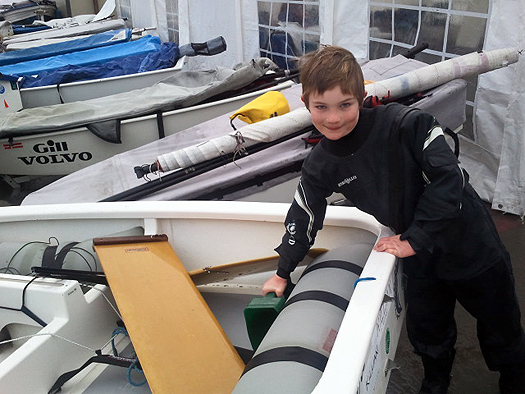
Killian did Baltimore Spring training last year; he sailed in the Regatta fleet in the Munsters in Tralee in 2011, did his ISA Level 1 in Schull during Summer 2011,and is ready to do more events in 2012. He sails in RCYC with his friend Conor who is here in Baltimore. After sailing is over, Killian goes home, has dinner, and then goes out playing rugby with his brothers and friends to wind down!
Conor Lee
Conor Lee turned 12 just before the Baltimore event. Conor sails in Galway Bay Sailing Club. Last year he won the first race of the Connacht regional championships in terrible weather and went on to win the Junior Silver trophy in that event. He also sailed in the Leinsters and the Nationals, and has made the 2012 Under 12 Squad which means he will be part of the Under 12 team participating in the UK Nationals in Pwllheli in August.

Conor has three brothers who also sail; Gavin and David are in the Regatta fleet this week in Baltimore, and his older brother Jack is sailing 420s in Schull this week, so Conor and his family are staying in Schull and driving to Baltimore every day.
When the Volvo Ocean Race came to Galway in 2010, the GBSC juniors did a 'sail parade' off the promenade in Salthill; Conor was part of that parade and it is one of the highlights of his sailing career. He is looking forward to the Ocean Race returning to Galway this year.
Cliodhna ní Shúilleabhán
Cliodhna ní Shúilleabhán began sailing when she was 9 years old. Her home club is Kinsale Yacht Club. She has an older Sorcha who sailed Optimists but is now sailing a Laser 4.7. Her brother Mícheal has just graduated from the Optimist Regatta fleet to the main fleet.

Cliodhna is part of the ISA Optimist squad who are sailing at the Baltimore clinic this year. Cliodhna had a great sailing year in 2011; she was third girl in the 2011 trials and earned a place on the Europeans team, competing in Tavira in Portugal. The sailing was great in Portugal, but so was the fun that Cliodhna had with the other Irish girls, Jil and Megan, and the girls from the New Zealand team.
Another highlight of last year was the Brassemermeer team event at Easter. A group of sailors travelled to the Netherlands to compete in the event, and Cliodhna had a great week with Alacoque, Chloe and Caitlin. It was hard to decide what was the best part of the event, the fantastic sunshine for the week, or the fact that Ireland won the team trophy!
Hugh Perrette
Hugh age 12 has just gone into the Senior Fleet. Hugh sails in the National Yacht Club in Dun Laoghaire. His parents don't sail but Hugh went on holiday in 2007 to Adrigole in Cork, did a sailing course, and never looked back. Hugh sailed in the Regatta fleet in 2010 and last year sailed in the Junior fleet, winning a prize in the Junior Silver at the Munster championships in Fenit.

Hugh trains with the OPG, the Dublin Bay training group, during the winter and will compete in his first trials in April. He is on holiday for this week in Baltimore and spends his free time with friends Heather, Conor and Evie who are also from the National, but has also made friends on the circuit from all over the country.
Tralee's Sophie Browne is January Sailor of the Month
#SAILOR OF THE MONTH – Sophie Browne of Tralee Bay and Royal Cork is Afloat.ie/Irish Independent "Sailor of the Month" for January after taking the Silver Medal in the Girls Division in the Optimist Worlds in New Zealand. She added it to the Gold in the Girls, and fourth overall, which she won from an enormous fleet in the last major European regatta of 2011, at Palma, Mallorca in December.

Sophie in action abroad in Palma (top) and at home
It's some going when you're just fourteen. Sophie is back at school now, trying to make up for lost study time. But if she gives it the same total dedication she put into each sailing campaign during recent years, she'll sail into a good leaving cert in due course.
Dedication is the name of the game, and the Browne family in Tralee are a byword for it. Normally, the adjudicators for the Sailor of the Month are very reluctant to make the award to the most junior helms. They grow up so quickly, there's something ephemeral about it all.
But even at only fourteen, there's nothing ephemeral about Sophie's success. Other kids may think too much about the glitzy side of championships, but Sophie Browne is well aware of the sheer hard work and unglamorous dedication which goes into that podium place.
After the big regatta in Palma in December, the European Optimist squad went out to New Zealand with high hopes. But the pre-Worlds and the Worlds were salutary experiences. Thoughtful observers were well aware of the rising talents of southeast Asia, and South America too, as well as New Zealand and Australia, but for most it was a daunting learning experience.
It's Singapore which is most clearly setting the pace. Kimberly Lim from the vibrant city-state was both top girl, and the new world champion. Sophie Browne was second in the girls, but was back in 13th overall. Yet she was still one of the best of the Europeans – the top British sailor, for instance, was back in 21st.
It's the first time a 14–year old helm has taken the monthly sailor title. We've had younger sailors sharing a title as crews on a Mirror dinghy, but this is the first driver. And we're certain sure it won't be the last we'll hear of Sophie Browne of Tralee Bay in international sailing.
Plucky Performance Gives Sophie 13th Overall
#optiworldsnz – Tralee's Sophie Browne got no chance to improve on her 13th overall when the last race of the Optimist World Championships in New Zealand was abandoned yesterday due to lack of wind. The only Irish competitor in the 208-boat competition has impressed all week with a plucky performance that kept her inside the top ten of the world's toughest youth fleet until the penultimate day, when she dropped from ninth to 13th.
Although finishing 13th overall, she was second girl overall which earns her the girl's silver medal.
The result is being hailed as a major success by her club Tralee Bay Sailing Club, the first time Ireland has faced world championship competition for over four years. During the week Irish support for Sophie came from all over the world including her club mate, the offshore sailing star Damian Foxall currently racing in the Volvo Ocean Race onboard Team Groupama.
The 2011 World Champion Optimist Dinghy Sailing is Kimberly Lim from Singapore.
The Delta Flag was raised at 10.41, meaning that racing would start at 11.41. It didn't take the 210 sailors long at all to get out onto the water. The wind was very mild, around 10 knots, but the sun came back out again.
Protests from yesterday's racing had been processed and when the updated provisional results were published, there was a change on the leadership board. Ryan Lo had to give up his third position to Javier Arribas who was previously fourth.
The first fleet started the race at 1208, but all reaces were abandoned at 1308. The wind was too light for the strong current and sailors were not able to make progress around the course. At 1350 the Race Committee decided to start race 12 again, but at 1427 the very hard call was made to abandon all races for the day which means that the World Championships are over.
The provisional leader board (for the individual racing) after 11 races shows: 1 Kimberly Lim (SIN) 70 points, 2 Bart Lambriex (NED) 74 points, 3 Javier Arribas (PER) 77 points, 4 Ryan Lo (SIN) 78 points, 5 Francisco Ducasse (CHI) 87 points, 6 Ahmad Syukri Abdul Aziz (MAS) 90 points, 7 Wade Waddell (USA) 96 points, 8 Gabriel Elstrodt (BRA) 109 points, 9 Rodrigo Luz (BRA) 112 points, 10 Leonard Takahashi-Fry (NZL) 114 points.
All our coverage of the Oppy worlds in New Zealand here
Sophie Sails into 13th Place at Optimist World Champs
#oppiewordsnz – A 14th and a 42nd scored in the penultimate rounds of the Optimist worlds today drop Ireland's Sophie Browne from ninth to 13th overall. Browne needs to move up ten points with a single day's racing left to sail in Napier, New Zealand tomorrow to secure a much sought after top ten result overall. Ireland's only contender at the world's top junior championships is the second placed girl overall in the 208–boat fleet, a magnificant performance for the Tralee 14year–old.
The Optimist World Championships saw wind, rain, fog and therefore poor visibility yesterday. It wasn't until 1350 that the decision was made for the competitors to go out on the water. The wind was 18 knots, it was still raining, and the swells were 2 metres high, but the event organisers were determined to complete three races.
Sophie started out with a solid performance and a fourth place. She continued to sail well and finished 14th in her second race but then slipped back in the third race ultimately finishing 42nd which resulted in her dropping to 13th overall on the leader board.
Browne Moves Back into the Top Ten in New Zealand
#optiworldsnz – Support from home including Volvo Ocean Race sailor Damian Foxall urged Sophie Browne back in to the top ten of the Optimist World Championships at Napier, New Zealand today. The 14 year old from Tralee maintained her position at the top of the leader board in one of the world's toughest youth sailing class against a fleet of 208 competitors drawn from 48 countries.
Day four saw racing resume for the 210 boat fleet following a lay day yesterday, and two races were successfully completed. Sophie placed 31st and 5th which, allowing for a discard, which means the Kerry sailor now climbs six places to ninth overall.
Support at home has been building throughout the week and last night from his base in Abu Dhabi Ireland's top offshore sailor Damian Foxall from Team Groupama added his support on afloat.ie
"Hi Sophie, Well done, great to see you are still forging ahead. Good luck for the rest. Maybe see you in Galway, hi to all the family" the Groupama crew boss wrote last night on this site.
Browne is the sole representative for Ireland at the Championships with racing having begun on New Year's Day.
The 210 competitors from 48 countries have been divided into six groups resulting in three fleets per race and a spectacle on the start line with seventy boats per race. Light winds have unfortunately hindered some racing with only one successful race being completed on both Day 1 and Day 3 however four successful races on Day 2 and two on Day 4 (today) tally an overall of eight solid results for Sophie, allowing for one discard. Sophie has maintained her position at the top of the leader board with all seven of her results in the top 20, three of which in the top 5. She is currently 9th overall with racing continuing until Monday the 9th.
It was busy at the breakfast table this morning with sailors keen to get back onto the water after a day of sight seeing.
Sailors went onto the water at the scheduled time to start the first race at 1025, but with winds between 1 and 4 knots, there was not much sailing.
"We made the call to send the sailors back to shore at 1245" according to Gerald Martin, Principle Race Officer. "No racing had been done, and it didn't look like anything was going to happen any time soon as there was hardly any wind" Mr Martin continues.
Sailors were called back onto the water by 1310, but it wasn't until 1535 before the first race of the day started. The leader board changed after the seventh race: Ryan Lo who held the first position was disqualified from race 7 and dropped to place 7. Bart Lambriex from the Netherlands who finished second in race 7 took over the leadership position.
Wind increased to 8 knots by the time the eight race started, and the race committee managed to do all three fleets. It was a long day for the sailors with many headed back to shore just before 1900.
Bart Lambriex finished 15th in the eight and last race but managed to keep his prime position om the overall scores, followed by Ahmad Syukri Abdul Aziz from Malaysia with Javier Arribas solid in place three. The first female sailor is Kimberly Lim from Singapore on place four.
Whether there will be any sailing tomorrow depends entirely on the weather. The weather prediction at 2200 are very strong winds: up to 31 knots, heavy rain: 13.9 mm/hr and very high swells. We expect the Race Committee to make a call first thing tomorrow morning.
The provisional leader board (for the individual racing) after 8 races shows: 1 Bart Lambriex (NED) 40 points, 2 Ahmad Syukri Abdul Aziz (MAS) 48 points, 3 Javier Arribas (PER) 48 points, 4 Kimberly Lim (SIN) 59 points, 5 Miel Verstraete (BEL) 61 points, 6 Ryan Lo (SIN) 68 points, 7 Leonard Takahashi-Fry (NZL) 68 points, 8 Maria Vittoria Marchesini (ITA) 70 points, 9 Sophie Browne (IRL) 73 points, 10 Rodrigo Luz (BRA) 78 points.
Optimist Class Seek New Talent in Baltimore
#optimist – Impressed with the sailing success of 14-year-old Sophie Browne in New Zealand this week? Could you be the next to represent Ireland on the world stage? The Irish Optimist class is making every effort to bring on as many 'Oppy' sailors as possible with an Invitation to all Optimist sailors to its 2012 Spring Training Week in Baltimore from 13-17 February 2011, the school half-term.
IODAI, the International Optimist Dinghy Association of Ireland, organises a Spring training week every year which is open to all Optimist sailors in Ireland.
Baltimore in West Cork sits near the very southern tip of Ireland on the beautiful southwest coast roughly mid-way between the busy tourist destination of Dingle and Kinsale. Slightly off the tourist trail, Baltimore has restrained a village atmosphere, but it still has plenty of top class accommodation and a great place to eat and drink.
The village of Baltimore will be taken over by approximately 150 sailors and their families for the week of February mid-term. Coaches have not yet been announced, but typically are a mix of the top Irish and international coaches; in 2011, the Irish coaches were joined by coaches from Denmark, Spain and Italy.
Training will be provided daily for sailors of all competencies, from those who have never sailed before – pre-Regatta fleet level - to those who are competing internationally.
The class particularly would like to encourage sailors who have not attended an event outside their own club in the past, to consider coming to Baltimore, which is a non-competitive, fun week intended to build enthusiasm for sailing and to allow sailors from around the country to get to know each other.
The Baltimore event is considered to be one of the top International clinics in Europe.
It is very much a family-oriented event, with a programme of activities for children too young to sail, and events also organised for adults, such as the 'How to Rig an Oppi' class for novice parents!
The event is organised by IODAI which is comprised of volunteers, mainly parents of sailors, who organise the Optimist events calendar. Because everyone is a volunteer, Baltimore is an 'all hands on deck' week, with parents encouraged to lend a hand with the work that goes into making it such a special event. Helping out with making sailors lunches, doing slip duty, rescue on the water, or safety checking of boats, means that parents will get to know each other just as well as the sailors do.
Evening activities are also on offer, including the ever-popular 'Pizza night with the Coaches', tours of the Baltimore castle and RNLI station, and cinema night. And of course the cake competition on the last day of sailing.
An IODAI forum takes place during the Baltimore week where all parents are invited to express their views or seek information on the running of the Optimist class.
Entry is open to all interested sailors and entry can be made through the online Sailracer system, or directly by contacting the organiser Aidan Staunton at [email protected].
Baltimore has accommodation to suit our Sailors with a wide selection of Holiday homes, Apartments, Bed & Breakfast and Casey Hotel. Families can choose somewhere near the harbour or centre of the town. Accommodation can be booked on www.baltimore.ie where you will find a comprehensive list of accommodation.






























